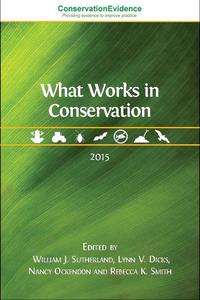1. AMPHIBIAN CONSERVATION. 1.1. Threat: Residential and commercial development. 1.2. Threat: Agriculture. 1.3. Threat: Energy production and mining. 1.4. Threat: Transportation and service corridors. 1.5. Threat: Biological resource use. 1.6. Threat: Human intrusions and disturbance. 1.7. Threat: Natural system modifications. 1.8. Threat: Invasive and other problematic species. 1.9. Threat: Pollution. 1.10. Threat: Climate change and severe weather. 1.11. Habitat protection. 1.12. Habitat restoration and creation. 1.13. Species management. 1.14. Education and awareness raising -- 2. BAT CONSERVATION. 2.1. Threat: Residential and commercial development. 2.2. Threat: Agriculture. 2.3. Threat: Energy production – wind turbines. 2.4. Threat: Energy production – mining. 2.5. Threat: Transportation and service corridors. 2.6. Threat: Biological resource use. 2.7. Threat: Human disturbance – caving and tourism. 2.8. Threat: Natural system modification – natural fire and fire suppression. 2.9. Threat: Invasive species. 2.10. Threat: Pollution. 2.11. Providing artificial roost structures for bats. 2.12. Education and awareness raising -- 3. BIRD CONSERVATION. 3.1. Habitat protection. 3.2. Education and awareness raising. 3.3. Threat: Residential and commercial development. 3.4. Threat: Agriculture. 3.5. Threat: Energy production and mining. 3.6. Threat: Transportation and service corridors. 3.7. Threat: Biological resource use. 3.8. Threat: Human intrusions and disturbance. 3.9. Threat: Naturalsystem modifications. 3.10. Habitat restoration and creation. 3.11. Threat: Invasive alien and other problematic species. 3.12. Threat: Pollution. 3.13. Threat: Climate change, extreme weather and geological events. 3.14. General responses to small/declining populations. 3.15. Captive breeding, rearing and releases (ex situ conservation) -- 4. FARMLAND CONSERVATION. 4.1. All farming systems. 4.2. Arable farming. 4.3. Perennial (non-timber) crops. 4.4. Livestock farming. 4.5.Threat: Residential and commercial development. 4.6. Threat: Agri-chemicals. 4.7. Threat: Transport and service corridors. 4.8. Threat: Hunting and trapping (for pest control, food or sport). 4.9. Threat: Natural system modification . 4.10. Threat: Invasive and other problematic species. 4.11. Threat: Education and awareness -- 5. SOME ASPECTS OF CONTROL OF FRESHWATER INVASIVE SPECIES. 5.1. Threat: Invasive amphibians. 5.2. Threat: Invasive crustaceans -- 6. SOME ASPECTS OF ENHANCING NATURAL PEST CONTROL. 6.1. Reducing agricultural pollution -- 6.2. All farming systems -- 6.3 Arable farming. 6.4. Perennial farming. 6.5. Livestock farming and pasture -- 7. ENHANCING SOIL FERTILITY. 7.1. Reducing agricultural pollution. 7.2. All farming systems. 7.3. Arable farming. 7.4. Livestock and pasture farming.
